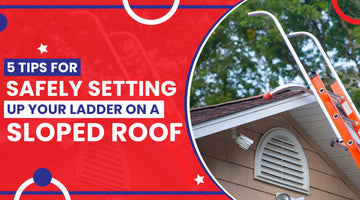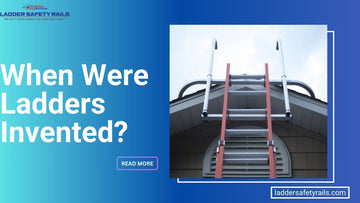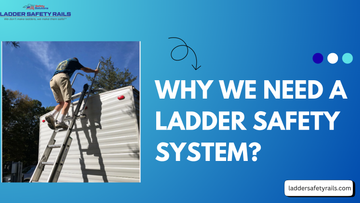
Ladders provide access for short-term jobs like gutter cleaning, exterior paint touch-ups, and holiday decor installations. Leaning a ladder against a sloped surface poses hazards like sideways sliding and imbalance. Thankfully, several specialized tools create flatter bases, enhance grip, and anchor ladders to keep them sturdy on angled roof lines and when working on flat side walls.
In this blog post, we will discuss five methods for securely placing a ladder on a slanted roof surface. We will also overview key safety considerations when working on pitched roofs and using ladders above ground level.
Is It Safe To Put A Ladder On A Sloped Roof?
With caution and the right gear, ladders can be safely positioned on sloped rooftops for temporary access. Key factors like proper weight distribution, using non-slip accessories, and securing ladder bases provide stability. For long-term roof access, articulating lifts and scaffolding offer safer alternatives overextended use of homemade ladders.
Factors To Consider When Putting A Ladder On A Sloping Roof

-
Roof Weight Capacity
Prior to ladder setup, confirm your roof's load-bearing capacity can support combined weights of the ladder itself plus climbers without risk of damage or collapse. Also check for fragile roofing materials susceptible to breakage under concentrated loads.
-
Ladder & Surface Grip
Rubberized ladder feet enhance grip on slippery metal and shingle surfaces. Non-slip pads and shoes prevent backwards sliding along angled roof planes. Clean dry surfaces also optimize traction and stability.
-
Proper Ladder Angle & Leveling
Specialized leveling tools like pivot ladder bases and adjustable ladder feet create an even, consistent plane for lateral ladder stability. Ladder Stabilizer bars also prevent sideways tipping along roof ridges and valleys.
-
Ladder Anchoring Methods
In addition to non-slip feet accessories, anchor ladder tops to rooflines using industrial-grade roof hooks. Tie base sections to stable posts using latching ladder leashes to prevent disengaging or slippage at foundations
-
Avoid Electrical Hazards
Finally, scout all work zones in advance checking for nearby power lines or exterior wiring running along rooftops. Adjust ladder positioning to prevent any electrical contacts.
5 Methods For Securely Placing A Ladder On A Slanted Roof

When ladder use on pitched rooftops cannot be avoided, use these five techniques paired with safety gear to stabilize positioning:
- Pivot Ladder Base Elevates ladder legs to an even plane. Use of rubberized bottom grips roofing surfaces and helps prevent slippage along slopes.
- Industrial Roof Anchor Hooks Heavy-duty metal hooks fit over peak to secure ladder top. Avoid roof damage by protecting contact points.
- Outrigger Stabilizer Bars Bolt multi-directional bars onto sides of ladder base section. Counteracts tipping forces from weight shifts.
- Ladder Leash System Nylon leash straps wrap around chimneys or posts. Tethers base of ladder in place to anchor footing.
- Roof Boot Platform Molded boot mounts provide deep cradle for ladder feet. Install built-in boots along ridges during roof construction.
While on slanted planes, always maintain three points of contact when climbing. Check ladders for electrical hazards before use. Don’t overreach or lean sideways as you’d like to maintain the centerline of the ladder as much as possible. Utilize safety accessories and smart climbing techniques together for secure ladder positioning on angled rooftops.
What are some Smart Ladder Placement Strategies?

-
Anchor with Roof Brackets
Specially-designed ladder brackets that mount over your roof’s ridge anchor your climbing equipment to the structure rather than just propping it up. This secures the ladder’s base, preventing backwards sliding on sloped surfaces. Roof anchor brackets also allow proper angle adjustment to match the exact slant of your roof for stabilized level climbing.
-
Bond with Friction
While securing brackets requires drilling permanent mounts, non-invasive options utilize good ‘ole friction to keep things in place. Position a ladder’s feet over shingles rather than sections of exposed felt since textured asphalt provides more grip. You can also opt for traction enhancers like slip-resistant ladder shoes, and pads placed under rails to prevent backwards sliding on smooth surfaces.
-
Brace Below
For multi-section extension models, brace the base section by driving a wooden stake or rebar into the ground behind the ladder’s feet prior to fully extending it upwards. This anchors the lower portion, counteracting the tilted angle of the fully elongated upper section resting against the roofline. Just beware of what lies underneath when driving posts for underground utilities!
-
Send Up Support
Station a helper at the base of the ladder to provide physical reinforcement by bracing their shoulder, foot or body against the back-side to counteract forces of gravity. While manageable for quick up-and-down trips, a human brace risks fatigue on longer jobs. Instead, they can use ropes, poles, or sandbags to weigh down high-traffic commercial ladders as a safer alternative to playing a living doorstop.
-
Call a Competent Pro
In lieu of risky homemade contraptions, call a trained service professional. Experienced roofing contractors bring extensive safety knowledge and proper equipment like adjustable ladders with reinforced rubberized feet, articulating platform lifts, and rigging apparatus designed specifically to provide stable, anchored access on sloped peaks. Safety comes first, so don’t let fears of high service fees put your wellbeing at risk on a questionable homemade setup.
Read More Blogs Here:
Conclusion
Specialized ladder tools allow home roof access for short-term jobs like gutter cleaning, holiday decorating, roof and home inspection which help follow essential safety protocol. However, minimize risky homemade ladder use on angled rooftops by calling insured professionals anytime extensive repairs or long-term tasks arise overhead. Take all necessary fall safety precautions when ladders cannot be avoided for quick external residential roof access.
Why Choose Safety Solutions For Your Ladder Sadety Needs?
Here at Safety Solutions, we supply extensively tested commercial-grade ladder safety equipment designed for enhanced stabilization, grip, visibility, and precautionary safety when working an extension ladder. Protect yourself on risky residential tasks by using proper ladder gear with proven reliability for the most challenging professional work sites!
FAQs
-
How do you secure a ladder on a slanted roof?
To secure a ladder on a slanted roof, use ladder stabilizers or standoff brackets to provide additional stability. Ensure the ladder is positioned securely and use roofing brackets or other accessories to prevent slipping.
-
How to safely use a ladder on a roof?
Place the ladder on a flat and stable surface, ensuring it extends at least 3 feet above the roof edge. Use stabilizers or standoff brackets to prevent slipping during use. Using the proper product will avoid leaning the ladder against gutters which can be an extremely dangerous practice.
-
How to climb a roof safely?
Always face the ladder while climbing, maintaining three points of contact with either hands and feet. Use a tool belt for carrying materials and avoid overreaching or leaning too far to maintain balance.
-
How to get on a roof with a ladder?
Set up the ladder at a safe angle, ensuring it extends beyond the roof edge. Climb the ladder slowly and deliberately, facing it directly, and step onto the roof while maintaining a firm grip on the ladder for stability.
-
How to put a ladder on a slanted roof?
Use ladder stabilizers or standoff brackets to secure the ladder on a slanted roof. Position the ladder with the base away from the roof edge, ensuring a secure and stable setup before climbing.






